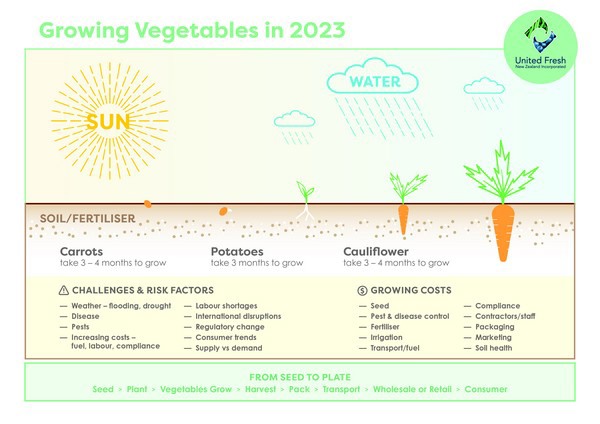The release of the March Food Price Index for New Zealand shows yet another month of disruption to the country’s fresh produce industry off the back of a challenging summer. Fruit and vegetable prices in March were up 22.2% on March 2022.

Months of tropical conditions, rain, wind and cyclones have seen growers throughout the North Island struggle to put food on our tables, and while the dominant La Niña weather pattern that brought this weather is switching to an El Niño one, the horticulture industry warns that significant challenges remain.
President of United Fresh, Jerry Prendergast, says the supply and demand model of the fresh produce industry means price fluctuations are unavoidable.
“Growing fresh fruit and vegetables is a complex and high pressure undertaking with a lot of variables. Fruit and vegetables are exposed to the elements, that’s what gives our produce that delicious flavour and high nutrient level. But this also means we’re vulnerable to adverse weather. Weather damage means a reset of the whole growing process which takes three to four months for crops such as carrots, potatoes and cauliflower. If prices are high, that’s because demand is high, and stock is low – which is why we always advise shoppers to buy fresh fruit and vegetables that are in season. If you’re buying a summer favourite such as tomatoes in late autumn, it’s going to cost more than it would in January.”
Prendergast notes that the FPI doesn’t tell the whole story of fruit and vegetable pricing. “The FPI uses a standardised ‘basket’ of goods. This doesn’t take into account the specials and seasonal pricing that are unique to the fruit and vegetable market. Shoppers that take advantage of those seasonal prices will find their costs have not risen nearly as much as the FPI would suggest,” he says.
As growers clean up their orchards and replant, the fresh produce market will soon see a return to regular trading conditions, but Prendergast warns that long-term challenges remain.
“Like every other industry, we’re still battling the high costs of fuel and fertiliser and the shortage of labour. While everyone is looking hard at cutting costs as much as possible, we can’t avoid passing some of that expense on,” says Prendergast.
More information about the monthly Food Price Index can be found on the StatsNZ Tatauranga Aotearoa website: https://www.stats.govt.nz/information-releases/food-price-index-march-2023/
 For more information:
For more information:
United Fresh
www.unitedfresh.co.nz
